Our Verdict
The upgraded Radeon RX 5500 XT 8GB gives you more memory, but the jump in pricing pits it against the GTX 1660, and it typically loses that matchup.
For
- Solid 1080p performance
- Efficient Navi architecture
- Plenty of VRAM
Against
- Slower than GTX 1660
- Higher generational pricing
PC Gamer's got your back
AMD's retail Radeon RX 5500 XT series of graphics cards bring additional options to the budget and mid-range graphics card market. I looked at the Radeon RX 5500 XT 4GB at launch, but there are also the 8GB cards. Just how much does doubling down on VRAM do for performance? As you'd expect, it depends on the games and settings you're running.
If you haven't read the 4GB model review, I suggest you start there. Back? Good. AMD's Navi / RDNA architecture hasn't changed, though Navi 14 does cut the potential number of compute units (CUs) from a maximum of 40 down to a maximum of 24—with the 5500 XT enabling 22 of the CUs. The two cards I've reviewed look identical, which is expected as both are Sapphire Pulse models. The only difference is the VRAM and a $30 increase in price.

While the specs might not have changed, other than VRAM, the price increase has some ramifications. The 5500 XT 4GB card matches up against the GTX 1650 Super, and the two are effectively tied in performance. The 8GB card meanwhile has to take on the GTX 1660, and Nvidia's card has the same number of GPU cores, 1,408. The problem for AMD is that Nvidia's GPU cores tend to perform a bit better overall, so the GTX 1660 comes out ahead in performance. At least the TDP is basically the same—120W vs 130W won't really matter either way.
There's little difference in features to speak of. Technically, Nvidia's GTX 1660 can enable ray tracing in games that support it. In practice, the 1660 isn't fast enough to make ray tracing worthwhile. There are other facets of performance—AMD GPUs often perform better in DirectX 12 games, Nvidia GPUs can do better in DX11 and other games—but overall the two sides are evenly matched in the mid-range and lower markets.
There's also a jump in generational pricing, especially looking at current street prices. The RX 590 originally launched at $279 last year; today, you can get that same card for $179. It uses more power, but performance is going to be very similar to the RX 5500 XT 8GB. Even AMD's own numbers say as much, where AMD compares the 5500 XT to the older RX 480 cards and claims a 30 percent improvement in performance. AMD's not wrong, but the RX 470/480 are three years old, so a 30 percent improvement at only slightly lower prices isn't all that impressive.
Which brings me to the real question: How does the RX 5500 XT 8GB perform? Let's get to the benchmarks.


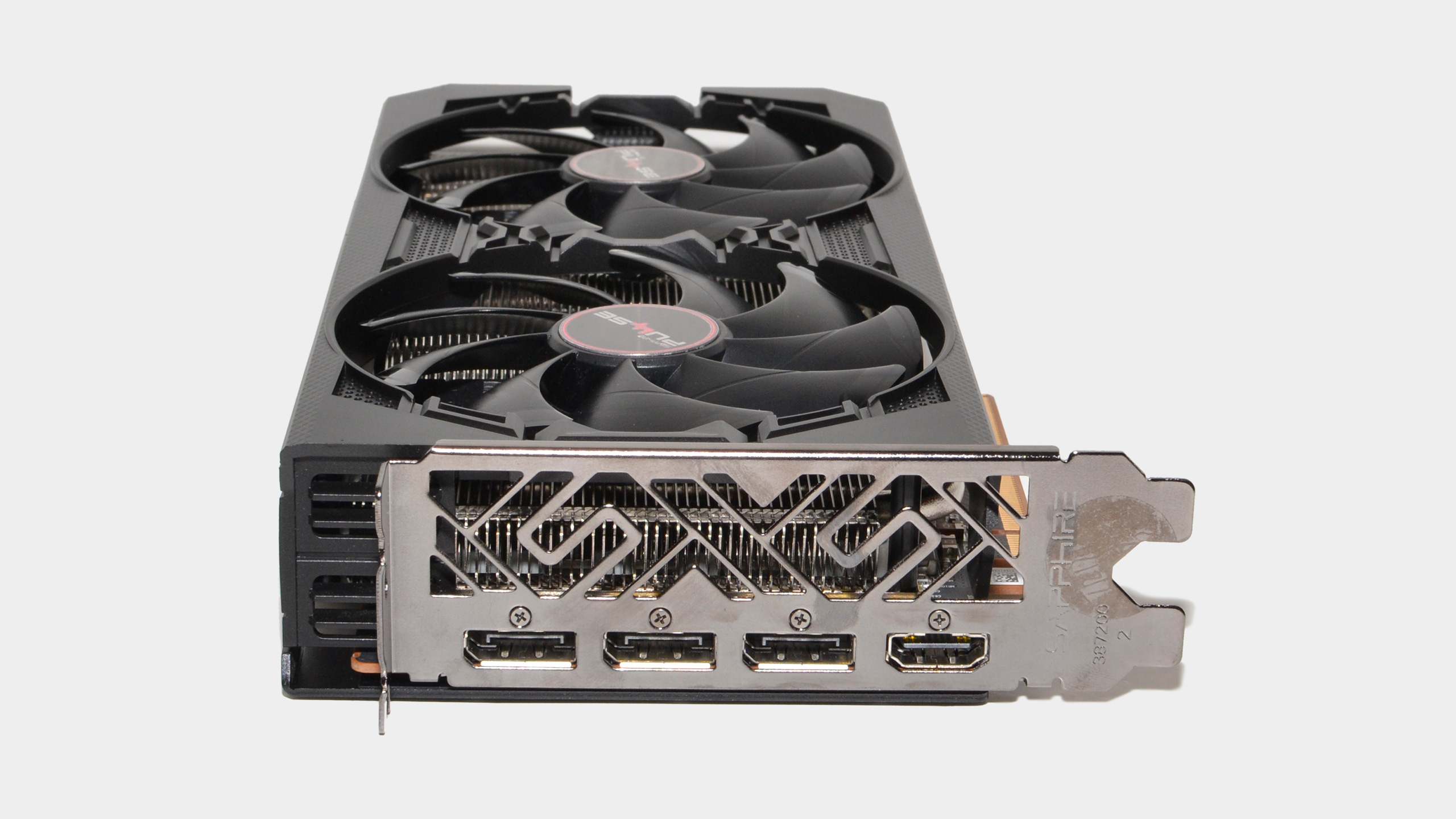

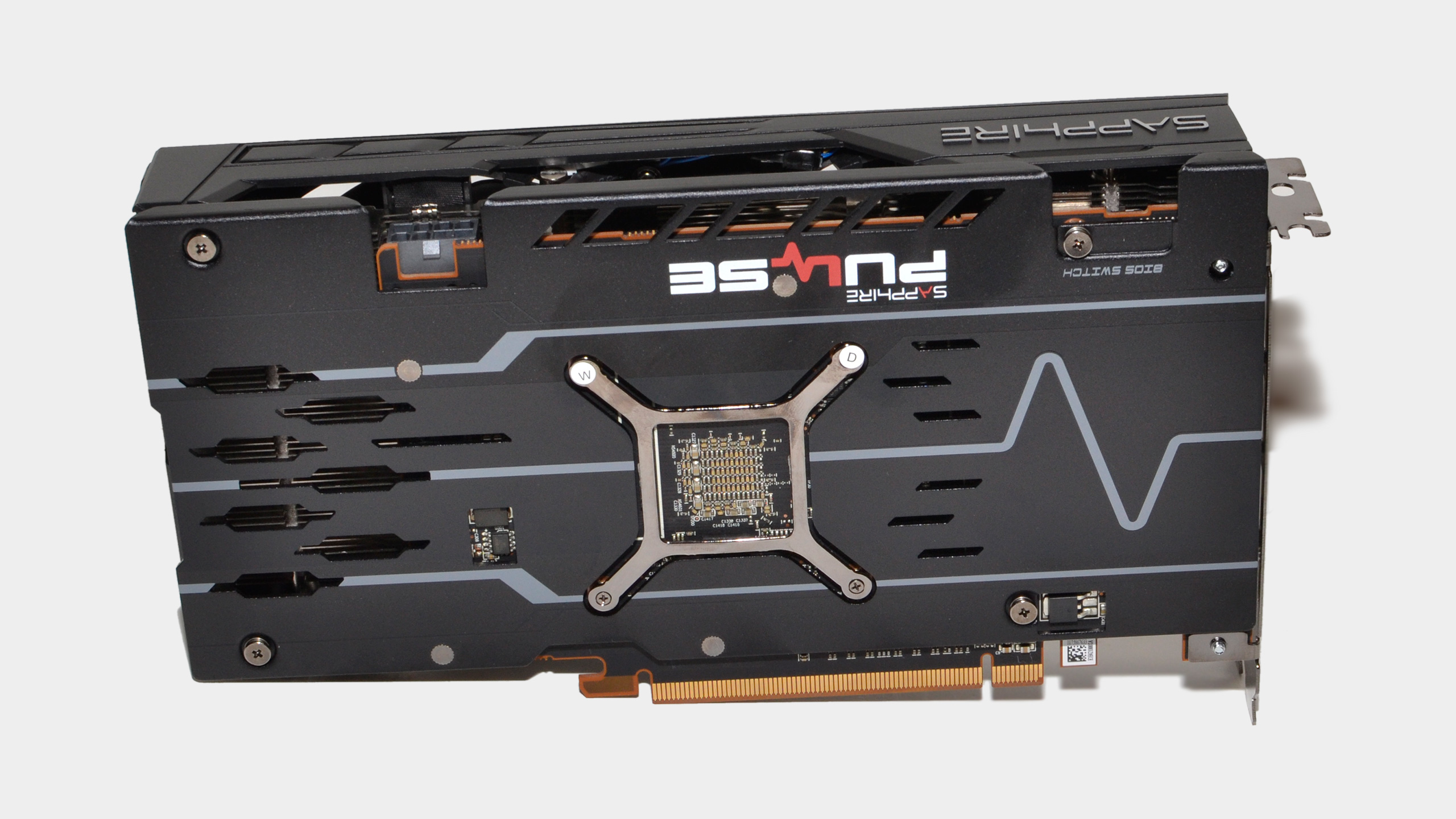

Radeon RX 5500 XT 8GB gaming performance
My standard testbed features an overclocked Core i7-8700K running at 5.0GHz. For budget and midrange cards, the CPU might be overkill, but it shows the highest potential performance for the graphics cards. Anyone considering the RX 5500 XT will probably be running a slightly slower CPU, but anything from the past several years should be sufficient. I've tested 11 games for this review, with a reasonable split between games that favor AMD hardware, and games that run better on Nvidia hardware.
Testing is done at 1080p 'medium' and 'ultra' settings (which may go by different names, depending on the game), as well as 1440p and 'ultra' settings. Each game is tested multiple times, using the median result, to ensure consistency of performance. I've included a few more GPUs this time, mostly for reference—if you're thinking about upgrading from a Vega 56, for example, the 5500 XT isn't going to be very compelling. It looks better against the old GTX 970 and R9 390, however.




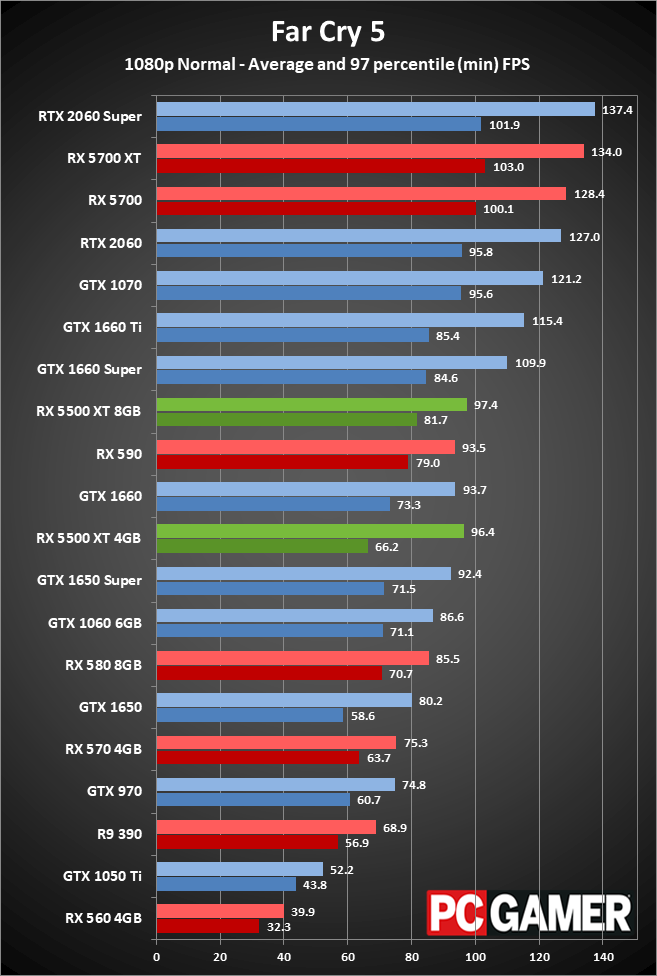







At 1080p medium, there's no real benefit to the 8GB RX 5500 XT compared to the 4GB model. A few games even perform slightly faster with the 4GB card, which is a bit odd—it's probably just slight differences in memory latency. The RX 5500 XT cards are also tied with the GTX 1650 Super in overall performance, but the GTX 1660 is about 5 percent faster. Running medium quality at 1080p isn't really the goal if you're going to pay extra for the 8GB card, however.
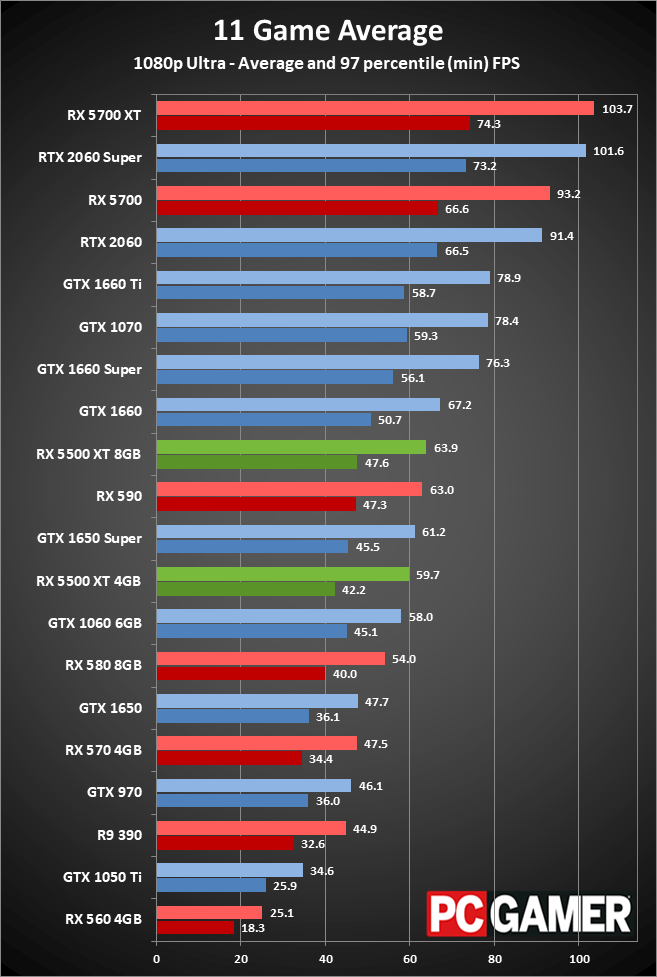











Stepping up to 1080p ultra starts to favor the 8GB model over its lesser sibling, though it's only a seven percent improvement on average. Individual games show much larger gains, though—Shadow of the Tomb Raider performance improves by 9 percent, Forza Horizon 4 runs 15 percent faster, Borderlands 3 is 18 percent faster, and Assassin's Creed Odyssey opens up a 33 percent gap. The remaining seven games all show relatively similar performance, but there have been quite a few recent games that I'm not showing here where having more VRAM would also be beneficial (eg, Red Dead Redemption 2).
The difficulty AMD faces is that at 1080p—which is really the resolution you should plan on using with a mid-range or budget GPU—even at maxed out quality there aren't a ton of games that truly need more VRAM. And of the games that benefit from more VRAM, none of them seem to need more than 6GB. That means once again that the GTX 1660 costs as much as the 5500 XT 8GB but performs about five percent better.
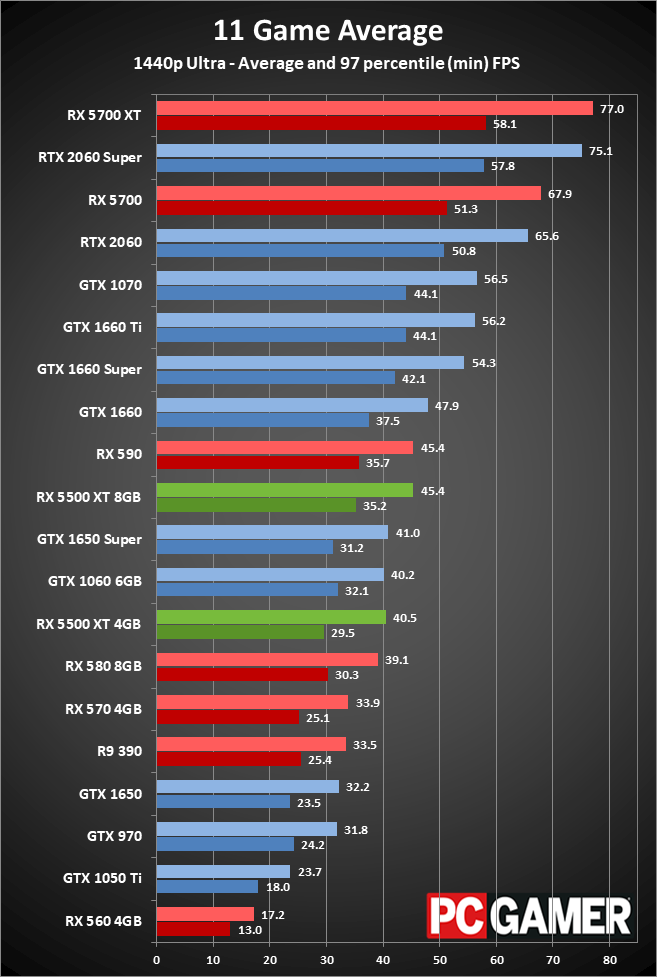











At 1440p ultra, the 5500 XT 8GB shows its largest lead yet relative to the 4GB cards. It's now 12 percent faster, but we're also looking at average performance across the test suite of 45 fps. Every game still stays above 30 fps, which means performance is still generally better than current consoles, but only two of the tested games (Strange Brigade and Forza Horizon 4) average 60 fps or more. Lighter esports games like CS:GO and Overwatch should be viable at 1440p, however.
I'm not showing 4K charts, because framerates are about half what you get at 1440p, but if you're wondering: the 8GB card ends up with a 25 percent average performance lead over the 4GB model. It also comes out tied with the 1660 at 4K ultra, though both sit at 25 fps. Long-term, the 6GB and 8GB cards are a safer choice than a 4GB card, and I wouldn't touch a 2GB model at this point, but if you want more performance, you'll still be better off getting a faster GPU rather than doubling VRAM.

AMD Radeon XT 5500 XT 8GB: more and less
As a general rule, I advise people not to skimp on VRAM. I've been saying that since the GTX 1060 3GB/6GB and RX 570/580 4GB/8GB launches several years back. Yes, it costs more for the higher VRAM models, and performance doesn't always improve a lot with the extra memory. Except when it does, and then you could end up very sad that you cheaped out on your graphics card and now have to turn down some settings. The RX 5500 XT 8GB is a continuation of that recommendation. You can save $30 by purchasing the 4GB model, but long-term I don't think that's the best plan.
That's the "more" part of the equation, but it's not a clear win and there's a reason I've scored this card slightly lower than the 4GB model. First, even across 11 games, the improvement in performance at 1080p ultra is mostly minor (with a few exceptions). In an AMD-only world, I still recommend buying the 8GB model, but AMD isn't alone, there are multiple other options. Nvidia's GTX 1660 costs the same as the 5500 XT 8GB, or you can spend another $30 to get a GTX 1660 Super.
Alternatively, look at more than just the price of the graphics card and its performance. Spending 15 percent more ($230) for a 20 percent increase in framerates (ie, GTX 1660 Super) is reasonable. However, if you're putting that card into a gaming PC that costs $500 for the other components, it's really $730 vs. $700—a mere 4 percent increase in total cost, for the same 20 percent improvement in performance. That's basically what the GTX 1660 Super offers. Or you could upgrade to an RTX 2060 and it would be $800 vs $700, a 14 percent increase in PC costs for a 45 percent jump in performance. Spending a bit more money for each higher tier of graphics performance is a slippery slope, but even if you stop at the $200 mark, the RX 5500 XT 8GB doesn't come out as the champion.
Ultimately, AMD's Radeon RX 5500 XT series is a reasonable offering in the budget to midrange graphics card market. It's not clearly superior to other options... but it's also not clearly worse.
If you're looking to buy a new graphics card, whether as an upgrade to an existing PC or as part of a new gaming PC build, it's worth a look. Performance of the 5500 XT 8GB is basically equal to the outgoing RX 590, while using about 100W less power. You wouldn't want to "upgrade" from a 590 to a 5500 XT, but if you're trying to choose between those two AMD options, I'd grab the newer model. If you're not set on AMD, however, I'd look to the GTX 1660 or 1660 Super.
The upgraded Radeon RX 5500 XT 8GB gives you more memory, but the jump in pricing pits it against the GTX 1660, and it typically loses that matchup.
Jarred's love of computers dates back to the dark ages when his dad brought home a DOS 2.3 PC and he left his C-64 behind. He eventually built his first custom PC in 1990 with a 286 12MHz, only to discover it was already woefully outdated when Wing Commander was released a few months later. He holds a BS in Computer Science from Brigham Young University and has been working as a tech journalist since 2004, writing for AnandTech, Maximum PC, and PC Gamer. From the first S3 Virge '3D decelerators' to today's GPUs, Jarred keeps up with all the latest graphics trends and is the one to ask about game performance.



